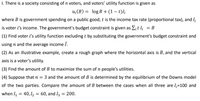
ENGR.ECONOMIC ANALYSIS
14th Edition
ISBN: 9780190931919
Author: NEWNAN
Publisher: Oxford University Press
expand_more
expand_more
format_list_bulleted
Concept explainers
Question
Only answer 3 and 4.

Transcribed Image Text:I. There is a society consisting of n voters, and voters' utility function is given as
u;(B) = log B + (1 – t)l;
where B is government spending on a public good, t is the income tax rate (proportional tax), and I
is voter i's income. The government's budget constraint is given as E¡ t I¡ = B
(1) Find voter i's utility function excluding t by substituting the government's budget constraint and
using n and the average income I.
(2) As an illustrative example, create a rough graph where the horizontal axis is B, and the vertical
axis is a voter's utility.
(3) Find the amount of B to maximize the sum of n people's utilities.
(4) Suppose that n = 3 and the amount of B is determined by the equilibrium of the Downs model
of the two parties. Compare the amount of B between the cases when all three are l;=100 and
when I = 40,12 = 60, and I3 = 200.
Expert Solution
This question has been solved!
Explore an expertly crafted, step-by-step solution for a thorough understanding of key concepts.
Step by stepSolved in 4 steps with 16 images

Knowledge Booster
Learn more about
Need a deep-dive on the concept behind this application? Look no further. Learn more about this topic, economics and related others by exploring similar questions and additional content below.Similar questions
- Kobmison Crusoe spends 4 hours a day catching fish and picking coconuts. He can always cateh 2 umioer of coconuts he eats per day and Fis the number of ish he eats per day, How many fish will he choose to eat per day? F= 2LF or -2/.arrow_forwardNonearrow_forwardSupply and Demand: End of Chapter Problems 9. Adjust each graph to show the indicated change. In each graph, click on the line or its midpoint to see the options. a. An increase in quantity demanded b. A decrease in demand Quantity Question Source: Chiang 4e- Economics Princidles FoHA Changing World Publisher: Worth 11:06 PI 65°F 10/13/20 Pricearrow_forward
- #14 Control Charts: Yellowstone National Park Yellowstone Park Medical Services provides emergency health care for park visitors. The average number of visitors treated is 21.7 per day during the summer period. The estimated standard deviation is 4.2 visitors. a. For a 10-day summer period, the following data show the number of visitors treated each day. Day 1 2 3 4 5 6 7 8 9 10 # 25 19 17 15 20 24 30 19 16 23 Make a control chart for the daily number of visitors treated and plot the data on the control chart. Does the data indicate that the number visitors treated is "in Control"? b. For another 10-day summer period, the following data saw obtained. Day 1 2 3 4 5 6 7 8 # 20 15 12 21 24 28 32 36 96 35 10 37 17 Make a control chart for the daily number of visitors treated and plot the data on the control chart. Does the data indicate that the number visitors treated is "in Control"?arrow_forwardA5arrow_forward2arrow_forward
- urgentarrow_forwardGovernments often require people to obtain insurance; for example, all drivers are required to carry auto insurance to cover damages to others in the event of a crash. Homeowners are often required by banks to carry insurance on their home. (a) Why do these requirements exist? (b) Would they be necessary if people truly recognized the risk they faced? (c) One characteristic of an overconfident person is that she is continually surprised when what she thought was unlikely orarrow_forwardYou have been driving for about 3 hours early in the morning which of the following indicates that you might be fatarrow_forward
arrow_back_ios
arrow_forward_ios
Recommended textbooks for you

 Principles of Economics (12th Edition)EconomicsISBN:9780134078779Author:Karl E. Case, Ray C. Fair, Sharon E. OsterPublisher:PEARSON
Principles of Economics (12th Edition)EconomicsISBN:9780134078779Author:Karl E. Case, Ray C. Fair, Sharon E. OsterPublisher:PEARSON Engineering Economy (17th Edition)EconomicsISBN:9780134870069Author:William G. Sullivan, Elin M. Wicks, C. Patrick KoellingPublisher:PEARSON
Engineering Economy (17th Edition)EconomicsISBN:9780134870069Author:William G. Sullivan, Elin M. Wicks, C. Patrick KoellingPublisher:PEARSON Principles of Economics (MindTap Course List)EconomicsISBN:9781305585126Author:N. Gregory MankiwPublisher:Cengage Learning
Principles of Economics (MindTap Course List)EconomicsISBN:9781305585126Author:N. Gregory MankiwPublisher:Cengage Learning Managerial Economics: A Problem Solving ApproachEconomicsISBN:9781337106665Author:Luke M. Froeb, Brian T. McCann, Michael R. Ward, Mike ShorPublisher:Cengage Learning
Managerial Economics: A Problem Solving ApproachEconomicsISBN:9781337106665Author:Luke M. Froeb, Brian T. McCann, Michael R. Ward, Mike ShorPublisher:Cengage Learning Managerial Economics & Business Strategy (Mcgraw-...EconomicsISBN:9781259290619Author:Michael Baye, Jeff PrincePublisher:McGraw-Hill Education
Managerial Economics & Business Strategy (Mcgraw-...EconomicsISBN:9781259290619Author:Michael Baye, Jeff PrincePublisher:McGraw-Hill Education


Principles of Economics (12th Edition)
Economics
ISBN:9780134078779
Author:Karl E. Case, Ray C. Fair, Sharon E. Oster
Publisher:PEARSON

Engineering Economy (17th Edition)
Economics
ISBN:9780134870069
Author:William G. Sullivan, Elin M. Wicks, C. Patrick Koelling
Publisher:PEARSON

Principles of Economics (MindTap Course List)
Economics
ISBN:9781305585126
Author:N. Gregory Mankiw
Publisher:Cengage Learning

Managerial Economics: A Problem Solving Approach
Economics
ISBN:9781337106665
Author:Luke M. Froeb, Brian T. McCann, Michael R. Ward, Mike Shor
Publisher:Cengage Learning

Managerial Economics & Business Strategy (Mcgraw-...
Economics
ISBN:9781259290619
Author:Michael Baye, Jeff Prince
Publisher:McGraw-Hill Education